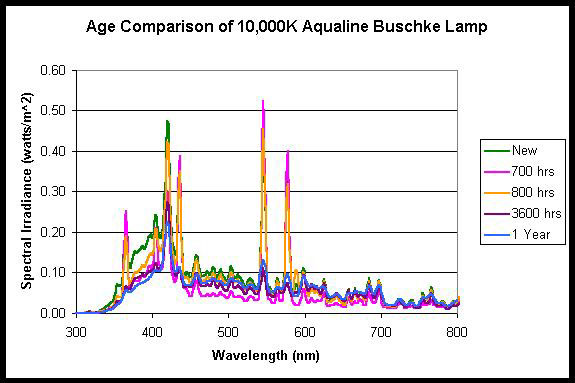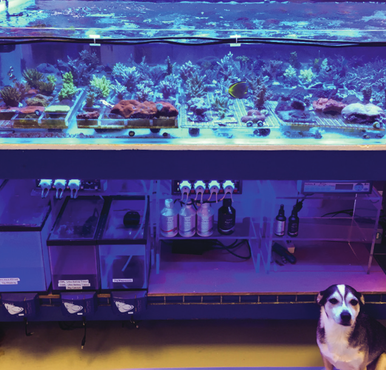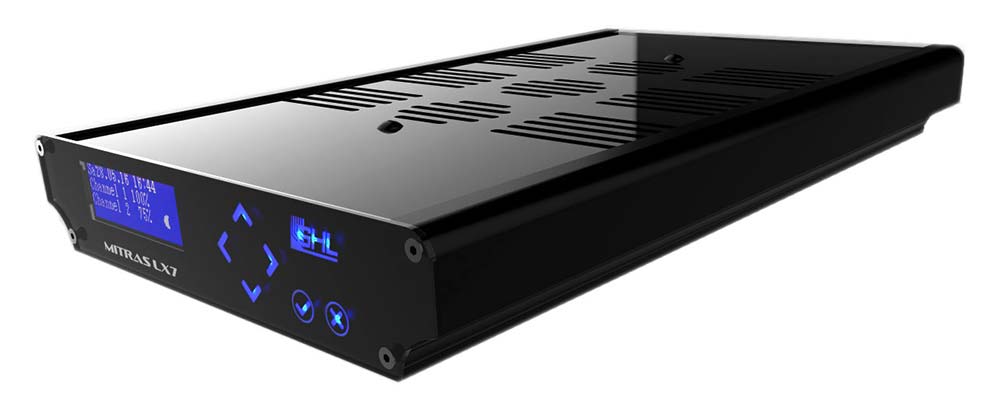- Joined
- Sep 18, 2017
- Messages
- 5,597
- Reaction score
- 3,447
Follow along with the video below to see how to install our site as a web app on your home screen.
Note: This feature may not be available in some browsers.
Its not my job to prove what you're saying - its your job



Hi, yes I have tried M/H, T5, VHO lights and every combination of these lights, and they are all good for growing and the coloration of SPS Corals, there is no denying that. I was very skeptical, just like you of LED lighting for growing corals, and the first version of the LED lights would grow coral, just not as good as the M/H light combinations. Then one or two of the LED manufactures figured out what it took to grow the SPS and other Corals just as good as the M/H manufactures did, and yes at a larger short term cost to the consumer, they preformed just as well as the M/H lights and any combination of the lights. As far as spectrum, the German lights are full spectrum, and have UV light transmission in the right NM numbers to satisfy the Corals demands, and they grow and color up just as good as any M/H combination on the market. There are light programs on the internet, that are very similar, or the same as the M/H 14K, or the M/H 20K bulbs , or any color combination of the M/H bulbs, that the end consumer of these LED's can use. What I love about the M/H lights or any combination of M/H lights with T5 or VHO bulbs, is they are so easy to use, and are cheaper in the short term. For me though, and where I live, the heat generated by my old M/H, VHO, T5 combinations was getting expensive to maintain in the long term compared to the LED Mitra Lights. The chiller and A/C fish room electrical cost could be made up in 3.5 years for me, so it seemed like a good time to change to the Mitra LED,s. Now if I lived in a cold climate, the electrical saving would not be worth it, as the heat generated by M/H, VHO, or T5 bulbs would help heat the water and house, thus reducing your heating bills. One more thing, I just love the ramping up and down of the Mitra lights, and their is, as of now no safe way to ramp up and down M/H bulbs, without the shortening of the bulbs already short life span. I get it you love your M/H lights, I really liked my M/H lights, but for me it was time to move on, and there is nothing wrong with either light type, as they both grow corals the same, with the same color spectrum to keep your corals thriving in our systems.Hi, what about the rest of my statements?
Does your German fixture produces and delivers more spectrum ends and uniformity, including the UV, than any halide in the market? No.
Have you tried halides to be able to compare?
Have you tried T5s yet?
See... PAR, distribution, spectrum, intensity work together.
If you tried halides and T5s before and prefer your LEDs, then it comes to a preference.
What everyone else is finding using their halides are better growth and better color. Those are facts in their opinion.
If you guys try to defend your LEDs, and we keep trying to defend our halides this way this thread will be repetitive and boring.
It's about the results and what you like. Everyone is different.
Yes M/H's are better at producing IR, but not UV with the New 1 or 2 high end LED fixtures on the market.They are the closest of all options because of the UV and IR.
Please do a search for the companies...
Corey how high above your water you place your fixtureThey bulbs and ballasts are going to be around for awhile I think. Hamilton technology has a great selection of stuff and I’m currently running 2 of their 250 bulbs and love them. 14K
Corey
Growth of what? Coloration of what? I assume you mean coral - does that mean all types of coral? Where has this been shown?Halides are known to be the best in terms of growth and coloration for a long time.
LED companies are constantly focusing on deceiving halides' kingdom to place their products on the throne, but they can't remove it's crown (the arc tube!)!!
They compare the Radions to T5s and Halides to proof their LEDs are actually better (?).
If they place the Halide/T5 fixtures where they were supposed to be placed for that comparison that wouldn't happen!!!
Does that work for that application? Yes. Will that be the case in most home systems? No.
They pretend to forget that halides are different and can offer what any LED just can't, like the UV and IR with a blended spectrum very similar to sunlight (when comparing to the other 2 artificial light source for aquariums). Just facts. Not saying it's better. But they are facts.
Does that mean halides are better?
No, they are just different and will show different results.
Next time say please. Be a good boy.
Nah. You're missing the heir apparent to the evil empire character that many political threads have. Its more like the good old Chevy vs Ford vs Chrysler arguments.These threads are the reef version of a political debate on social media. Nobody’s mind will EVER be changed despite any evidence or argument for either side. Just the way it is.
Even the Atlantik V4, which I consider the best LED on the market BY A MILE does not even pop UV like MH do. There is no comparison. Does it matter? Maybe? Maybe not? Who knows for sure? Most of the rest only dabble in UV with spillover from non-UV Violet LEDs - a white lie by the manufacturer, but a common one that everybody has come to live with.
We have covered this like 50 times in these 33 pages... yes, IR and UV can penetrate at least several meters in the ocean in dirtier water than what we keep in our tanks. This is no problem since nearly all of the tanks on this board are less than 2 meters deep. Yes, just about any coral can use UV for energy AND for color (reflectance and also re-emittance). You can believe what you want with IR, but the Emerson Effect literature seems pretty convincing to me along with the fact that IR producing lights can offer twice (or more) the PPFD without harming coral that light that does not have it, which also supports Emerson Effect theories. Again, Orphek made a good choice adding in 850nm here, IMO. Do you need any of this? Dunno? Do the lights that offer both UV and IR have some advantages - it seems so. I do find it funny that the V4 chart posted above does not go to 850nm even though the fixture does have 850nm diodes. There is some smoke here that points to both UV and IR being important.
Before this gets brought up again, the two-three meters that both UV and IR can penetrate ocean water is where nearly all of the corals that we have in our tanks come from. The masses of coral collected for the hobby are done on one-breath or wading in waist-deep water. There are studies that suggest that they both can penetrate to 10 meters, but we can table this and use the charts that Data posted a week, or so, ago.
I agree with everything you said - not sure why you thought it was up for discussion. Certain types of IR and UV penetrate saltwater. Certain types of IR do not.
Im no expert in MH or LED lighting - you know far more than I ever will. I was trying to ask @A. grandis a couple specific questions based on his prior post to try to figure out WHY MH may be better than LEDs.
There is a difference between MH and LED in the amount of IR and UV produced. OK. Where is the data that this difference is the significant - ie most important reason that growth and color are better with MH (if indeed they are per @A. grandis ?). The reason I'm trying to get an answer to this question - (and you seem to have answered it already that 'no one knows') is everyone keeps mentioning IR and UV as being the major difference between MH and LED - but have no evidence (but I admit I may be forgetting some) - that these are beneficial to 'coral in general' (i.e. essential)
My Opinion: Coral coloration is very subjective. The amount, intensity and spectrum of light all are important. Rather than which light is being used (other than personal preference as to how the tank 'looks', cost, heat, etc) - the most important factor is that amount of light (duration/intensity) presented to the corals throughout the day. For example - if a person uses a MH fixture for 8 hours a day - this is not the same as someone using an LED fixture for 8 hours a day at 50% intensity with an hour ramp up and ramp down. The tank with the MH fixture is receiving far more total radiation. (and by the way - in Florida the daylight period ranges between. 11 and nearly 14 hours/day - yet how many people leave their lights on that long - even with ramping.? (IDK)
I dont recall you answering this - though - back to the original poll/thread - which was not about wavelengths, etc - but instead was 'Would you ever use Metal Halide AGAIN'? 60% of people said No. 25% said yes. My point being - there doesn't seem to be a groundswell of people running back to MH. If one system were so clearly better - what is your opinion as to why so many people don't choose to use it? Advertising? Availability? Some other reason? That said - maybe people misunderstood the poll.
I hit most of this in post #5.
You are absolutely correct it is just like audio. Folks far more experienced in audio than either you or I have (and had the opportunity to work with or under Dr Floyd Tool at the NRC) conducted proper double blind testing and the result was ...The parallels to photography or even music are good. Of course, there are holes in any equivalency, but these are as good as any. I also collect and like to listen to vinyl. Leaving the collecting side out of it and the massive increases in value of some records lately, there are people who just don't believe that vinyl sounds better than even a lossless digital medium or a CD. Once they get to hear it, mostly at my house, then every single one of them had to agree that they were wrong and the vinyl does sound better - not a single person did not agree. ...
48”x18”dx24”h. 2 Lumenbrite mini 15” octagon. End to end top to bottom sps
